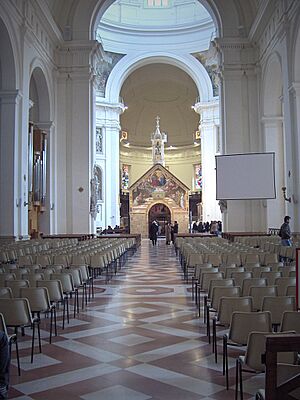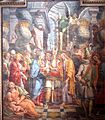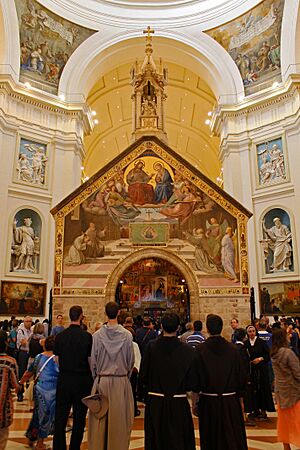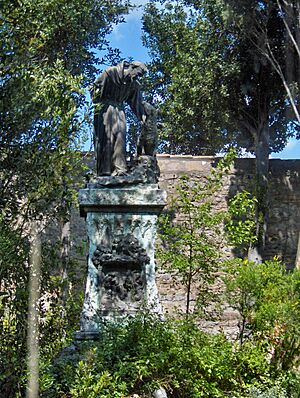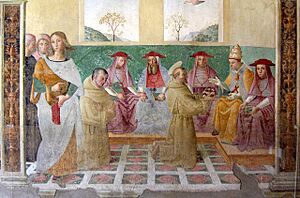Papal Basilica of Saint Mary of the Angels in Assisi facts for kids
Quick facts for kids Basilica of Saint Mary of the Angels |
|
|---|---|
|
Basilica di Santa Maria Degli Angeli
|
|
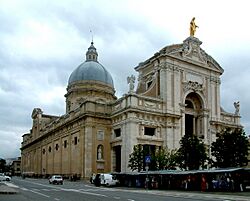 |
|
| Location | Assisi |
| Country | Italy |
| Denomination | Roman Catholic |
| History | |
| Status | Papal minor basilica |
| Consecrated | 1679 |
| Architecture | |
| Functional status | Active |
| Architect(s) | Galeazzo Alessi and Vignola |
| Architectural type | Church |
| Style | Mannerist; Baroque |
| Years built | 1569–1679 1836–1840 (reconstruction) |
| Specifications | |
| Length | 126 metres (413 ft) |
| Width | 65 metres (213 ft) |
| Number of domes | 1 |
| Dome height (outer) | 75 metres (246 ft) |
| Administration | |
| Diocese | Assisi-Nocera Umbra-Gualdo Tadino |
| Province | Perugia-Città della Pieve |
| Division | Pontifical Legation for the Basilicas of St. Francis and St. Mary of the Angels |
The Basilica of Saint Mary of the Angels (Italian: Basilica di Santa Maria degli Angeli) is a large and important church in Assisi, Italy. It is called a "papal minor basilica" because it has special ties to the Pope. This church is built on flat land at the bottom of the hill where the town of Assisi sits.
This huge church was built between 1569 and 1679. It was designed in a style called Mannerist, which was a step towards the later Baroque style. Inside this big basilica, you'll find a much smaller, older church from the 9th century called the Porziuncola. This little church is very special to the Franciscans, a religious group. It was here that a young man named Francis of Assisi realized his calling. He decided to give up his wealth and live a simple life among the poor. This was the beginning of the Franciscan movement.
Contents
History of the Basilica
After Saint Francis passed away in 1226, his followers, called friars, built small huts around the Porziuncola. Over time, they added more buildings, like a dining hall, around the little church. During digs between 1967 and 1969, workers found parts of these old buildings under the floor of the current basilica.
Building the Big Church
Many pilgrims, or religious travelers, came to Assisi to receive the "Pardon of Assisi". This meant the small Porziuncola church became too crowded for everyone. So, people decided a much larger church was needed to hold the Porziuncola inside it. Most of the buildings around the Porziuncola were taken down by order of Pope Pius V. Only the Chapel of the Transito, where Saint Francis died, was kept. Building the new, big basilica began on March 25, 1569.
This grand church is one of the largest Christian churches in the world. It was designed by two famous architects, Galeazzo Alessi and Vignola. The building work was slow because there wasn't always enough money. The project relied on donations from people. The impressive dome, which sits on an eight-sided base with eight windows, was finished in 1667. The entire church was finally completed in 1679. A bell tower was added in 1684, though a second one was planned but never built.
Rebuilding After an Earthquake
On March 15, 1832, a strong earthquake hit the area. The main part of the church, called the nave, and some side areas collapsed. The dome survived but had a big crack. The back part of the church, called the apse, and the side chapels remained standing.
Reconstruction of the basilica started in 1836. An architect named Luigi Poletti led the work, and the church reopened in 1840. He redesigned the front of the church in a neoclassical style. Later, between 1924 and 1930, another architect, Cesare Bazzani, changed the front back to its original style. In 1930, a gold-plated statue of the Madonna Degli Angeli (meaning "Madonna of the Angels") was placed on top of the church's front.
In 1909, Pope Pius X gave the church the special title of "patriarchal basilica and papal chapel."
What the Basilica Looks Like Inside
The basilica has a rectangular shape. It has a main central area (the nave) and two side aisles. Along the sides are ten smaller chapels. At the very end, there's a transept (a part that crosses the main body of the church) and a long, rounded choir area. The small Porziuncola church is located right under the main dome.
The inside of the basilica is simple but elegant, with few decorations in the main areas. This is a big difference from the side chapels, which are much more decorated. The main nave and aisles were rebuilt in a Doric style by Luigi Poletti. The back of the church has beautiful wooden choir stalls, carved by Franciscan brothers starting in 1689. It also has the Pope's special chair and altar.
Special Chapels
The Chapel of the Transito is still preserved inside the basilica. This is the small room where Saint Francis died on October 3, 1226. It was originally a simple hut used for sick friars. It is located near the choir, under the dome.
The side chapels are filled with amazing artwork by famous artists from different times. These include Antonio Circignani, Francesco Appiani, and Ventura Salimbeni.
The Porziuncola: A Tiny, Sacred Church
The chiesetta (meaning "little church") of Porziuncola is the most holy place for Franciscans. This small church dates back to the 9th century. It was given to Saint Francis by Benedictine monks.
Artists from many different periods have decorated the Porziuncola. Above the entrance, there's a fresco (a painting on wet plaster) by Johann Friedrich Overbeck (1829). It shows Saint Francis receiving a special "Pardon of Assisi" from Christ and the Virgin Mary. On the right side wall, you can see parts of two older frescoes by an unknown artist from the Umbria region.
The inside of the Porziuncola is simple and has a Gothic style. It features frescoes from the 14th and 15th centuries. The most impressive artwork is a six-part fresco in the back of the church, painted by Ilario da Viterbo in 1393. Above the entrance inside, there's also a fresco of the Crucifixion by Pietro Perugino.
The Transito: Where St. Francis Died
The Cappella del Transito is the small room where Saint Francis passed away on October 3, 1226. It was once a simple hut used as a place for the sick. On the outside, there's a fresco called The transito by Domenico Bruschi (1886). Inside, above a small altar, you can see Saint Francis's rope. Behind the altar is a beautiful statue of Saint Francis made of terracotta (a type of clay) with a shiny glaze. This statue was made by Andrea della Robbia around 1490. On the walls, a fresco by Giovanni Spagna (1520) shows Saint Francis's first followers, with their names written above each person.
The Crypt
A new crypt, or underground room, was built behind the main altar between 1965 and 1970. During the digging, workers found the foundations of the original small huts that surrounded the Porziuncola. The altar in the crypt rests on a large, sculpted tree trunk. Behind the altar, there's an enameled terracotta artwork by Andrea della Robbia. It shows different scenes with great detail and emotion. The top part shows St Francis receiving the Stigmata, the Coronation of Mary, and St Jerome the Penitent. The bottom part shows the Annunciation, the Nativity, and the Adoration by the Magi.
The Rose Garden and Rose Chapel
You can enter the rose garden through the sacristy (a room where priests prepare). This garden is the last remaining part of the old forest where Saint Francis and his friars lived. It's said that he talked to the turtle doves here, asking them to praise God. Doves have been nesting in the hands of the statue of Saint Francis in this garden for a very long time.
There's a traditional story that one night, Saint Francis was struggling with doubts and temptations. To overcome them, he rolled naked in thorny bushes. When his body touched the thorns, they turned into thornless dog roses. Since then, a special kind of thornless rose, called Rosa canina assisiensis, has grown in this garden.
From the rose garden, you can go into the Rose Chapel. This was the small room where Saint Francis rested and spent nights in prayer. It's also where Saint Francis met Saint Anthony of Padua. After Saint Francis died, a chapel was built here in the 13th century. It was made larger in the 15th century by Saint Bernardine of Siena. Between 1506 and 1516, the chapel was decorated with frescoes by several painters, including Tiberio d'Assisi. These paintings show the early Franciscan community, the first saints of the order, the miracle of the roses, and the granting of the indulgence.
Museum of the Porziuncola
The small friary (monastery) next to the basilica has a museum. It displays many religious items, old archaeological finds, and a great collection of paintings. Some of the important artworks include:
- The Crucifix by Giunta Pisano (1236).
- A wooden painting, a portrait of St. Francis, by an unknown artist called the Maestro di San Francesco (13th century). Saint Francis's body was placed on this painting after he died.
- A painting of St. Francis on wood, believed to be by Cimabue.
- A Madonna with Child by the Sienese painter Sano di Pietro (15th century).
- A terracotta artwork by Andrea della Robbia (around 1490). It shows St. Francis receives the Stigmata, Coronation of Mary, and St. Jerome the penitent at the top. At the bottom, it shows the Annunciation, the Nativity, and the Adoration of the Magi.
- St. Francis and St. Clare by Cesare Sermei and his workshop.
- The Madonna of the Milk, a colorful terracotta sculpture from the late 14th or early 15th century.
- Many frescoes by artists whose names are not fully known.
See also
- Roman Catholic Marian churches
- Los Angeles – a city indirectly named after this church


